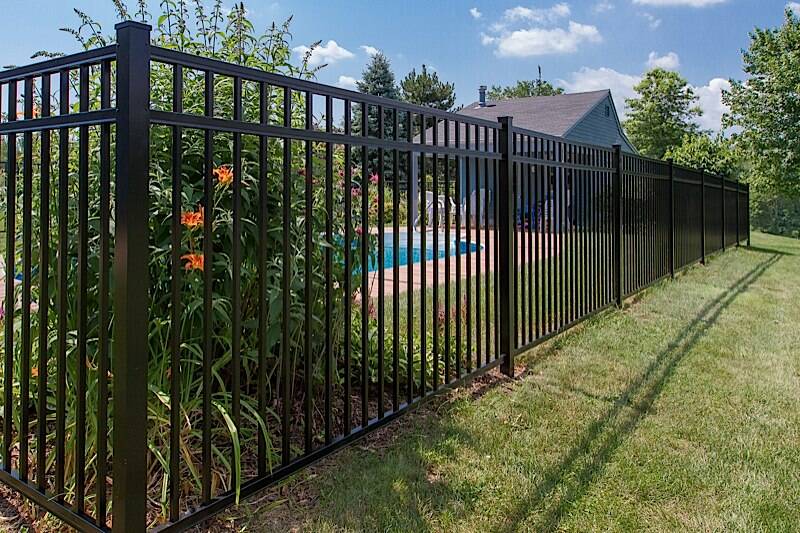Durability and Climate Resistance of Garden Fence Materials
How Material Composition Affects Longevity in Outdoor Conditions
How long a garden fence will last really depends on what it's made from. Take wood for example - because of its natural cellulose makeup, it tends to rot when exposed to fungi. We've seen tests showing wood fences degrade about 15 percent quicker in areas with high humidity levels. On the other side of things, galvanized steel has this zinc layer that stops rust from forming, which helps protect against corrosion over time. Then there's vinyl or PVC fencing options that just don't absorb water at all. These synthetic materials maintain their shape and strength much better than traditional organic ones like wood, especially after years of exposure to weather conditions that would break down natural materials completely.
Galvanized Wire and Metal Fencing Performance in Humid and Coastal Climates
Salt-laden air accelerates corrosion in standard metals by 40%, but hot-dip galvanized wire withstands coastal exposure for over 20 years. Powder-coated aluminum offers comparable rust resistance with 30% less weight, though thinner gauges may dent during extreme storms.
Wood and Bamboo in Arid vs. High-Moisture Environments
Untreated cedar warps three times faster than pressure-treated pine in arid climates, while bamboo’s hollow stalks trap moisture, increasing mold risk in rainy regions. Proper sealing extends wood lifespan to 12–15 years in wet zones, though maintenance costs rise by $180 annually (National Gardening Survey 2023).
Vinyl/PVC Stability in Extreme Temperature Fluctuations
Vinyl maintains flexibility between -30°F and 140°F, resisting cracking common in brittle plastics. Unlike wood, which expands and contracts up to 8% seasonally, PVC shifts by ≤0.5%, helping retain post anchors in frost-prone areas.
Selecting Materials Based on Regional Weather Patterns
| Climate Type | Optimal Fence Material | Avg. Lifespan |
|---|---|---|
| Coastal Humid | Galvanized Steel | 25 years |
| Desert/Arid | Vinyl-Coated Chain Link | 18 years |
| Temperate Rainfall | Pressure-Treated Wood | 15 years |
| Extreme Seasonal Shift | Cellular PVC | 30+ years |
Match thermal expansion rates and moisture resistance to your region's 10-year weather history for optimal performance and cost efficiency.
Maintenance Needs Across Popular Garden Fence Types

Understanding the Hidden Costs of High-Maintenance Fencing
Wood fences offer natural charm but demand recurring upkeep: biennial resealing ($120–$300) and annual board replacements (5–10%). Galvanized wire requires minimal care but benefits from rust inspections in coastal areas. Polyethylene fencing averages under five hours of maintenance yearly, saving $740–$1,100 over five years compared to wood (2024 Outdoor Materials Report).
Material-Specific Care: Wood, Vinyl-Coated Wire, and Polyethylene
- Wood: Semi-annual rot checks, biyearly staining, and post-storm structural assessments
- Vinyl-coated wire: Annual hinge lubrication and vegetation clearance around posts to prevent moisture retention
- Polyethylene: Monthly debris rinsing and UV protectant application every three years in high-sun regions
Five-Year Comparison: Wood vs. Low-Maintenance Poly Fencing
| Maintenance Factor | Wood Fencing | Polyethylene Fencing |
|---|---|---|
| Annual Time Investment | 12–18 hours | 3–5 hours |
| Material Costs | $90–$220/year | $25–$60/year |
| Climate Limitations | Prone to warping/swelling | Stable ±50°F tolerance |
| Lifespan with Care | 7–12 years | 15–25 years |
Choosing Rot, Rust, and Insect Resistant Options
Vinyl and powder-coated aluminum resist moisture damage in humid environments, while composite blends deter termites. For coastal installations, stainless steel hardware reduces corrosion by 72% compared to standard galvanized components (2023 Coastal Construction Study).
Strategies to Minimize Long-Term Upkeep Efforts
- Install gravel borders to prevent ground-contact wood rot
- Apply UV-blocking sealants on south-facing poly sections
- Use pre-treated posts with copper naphthenate protection
- Schedule professional inspections after severe weather
These practices can extend fence life by 40–60% across all materials while preserving appearance and function.
Aesthetic Integration of Garden Fences in Residential Landscaping
Enhancing Curb Appeal and Property Value with Fence Design
A well-designed garden fence can boost curb appeal by 5–15% (National Association of Realtors, 2023), framing flower beds and hardscaping elements effectively. Horizontal cedar slats or powder-coated steel add modern lines to older homes, while lattice-top vinyl complements traditional architecture.
Matching Fence Style to Garden Themes (e.g., Zen, Modern, Cottage)
| Garden Theme | Ideal Fencing Material | Design Features |
|---|---|---|
| Zen | Bamboo | Natural tones, staggered rows |
| Modern | Galvanized steel | Angular geometric patterns |
| Cottage | Painted picket | Decorative post caps |
This alignment enhances landscape cohesion—split-rail fencing suits wildflower meadows, while laser-cut aluminum fits minimalist xeriscapes.
Bamboo Fencing in Tranquil, Nature-Inspired Gardens
Bamboo's vertical stalks cast rhythmic shadows ideal for meditation spaces, contributing to 34% higher homeowner satisfaction in drought-prone areas (Drought-Tolerant Landscaping Survey, 2024). Kiln-dried poles treated with borate solutions resist splitting and fungal growth in humid conditions.
Rising Popularity of Composite and Sleek Metal Designs
Composite fencing sales rose 18% year-over-year in 2023 due to realistic wood-grain finishes and fade resistance. Powder-coated steel grids with integrated planter shelves reflect the hybrid material trend, combining industrial strength with biophilic design.
Balancing Visual Appeal with Privacy and Functionality
Woven willow screens or staggered board-on-board wood fences block 85% of light while allowing airflow—ideal for vegetable gardens needing partial shade. In suburban settings, 6-ft vinyl panels with frosted glass inserts reduce noise by 12 decibels without sacrificing sunlight access.
Cost-Effectiveness and Budget Considerations for Garden Fences
Initial Cost vs. Long-Term Value: Wood, Vinyl, Metal, and Poly Options
When thinking about what materials to use for outdoor projects around the house, most folks need to consider how much they're spending upfront versus how long things will last. Take pressure treated wood for instance it typically runs between seven and fifteen dollars per linear foot, but homeowners should remember that it requires sealing again roughly every couple of years. Vinyl options come at a higher price tag, usually twenty to forty bucks per foot, yet these can stick around for more than twenty years without needing much attention at all. Galvanized steel sits somewhere in the middle at around twelve to eighteen dollars per foot and stands up better to rust compared to regular metal. Meanwhile polyethylene is cheaper at eight to twelve dollars per foot and handles sunlight pretty well, though it might start sagging when winter gets really cold outside.
ROI Comparison: Galvanized Wire vs. Composite Fencing
Galvanized wire costs $3–$7 per foot, offering short-term savings but limited rigidity for security use. Composite materials ($22–$35/ft) blend recycled plastics and wood fibers, delivering a service life 50% longer than traditional wood according to a 2025 agricultural technology analysis, making them more economical over a decade.
Temporary vs. Permanent Solutions for Seasonal Garden Use
For seasonal vegetable beds, rollable polyethylene mesh ($0.50–$1.50/sq.ft) outperforms chicken wire in cost and storage ease. Permanent decorative fencing typically uses vinyl-coated steel or cedar lattice ($18–$30/ft), with vinyl requiring 73% less seasonal upkeep than natural wood based on homeowner surveys.
Affordable Materials That Deliver Durability and Style
Treated pine ($6–$10/ft) and aluminum slats ($15–$25/ft) now feature textured finishes that mimic premium hardwoods. Bamboo rolls ($4–$8/ft) offer tropical aesthetics at 40% lower cost than reed fencing, though they last only 3–5 years in humid climates.
Budget Planning Tips for DIY and Professional Installations
- Obtain permits early to avoid 15–25% project overruns
- Professional installation adds $5–12/ft but ensures proper warranty coverage
- Purchase materials in bulk during offseason (January–March) for 10–30% discounts
- Allocate 8–12% of the budget for gates and corrosion-resistant hardware
Performance Breakdown: Wood, Vinyl, Metal, and Bamboo
Pressure treated wood looks great and has that traditional charm most people love, though it needs sealing every six months if installed somewhere damp. Vinyl is pretty tough stuff actually, holding up against temperatures ranging all the way from below freezing at minus 30 degrees Fahrenheit right up to scorching 120 degrees according to recent material stability reports. Galvanized metal stands up better to salt air near the coast compared to regular steel, lasting about three times as long before showing signs of rust. Bamboo works fine where it stays relatively dry, but watch out for places where moisture levels regularly go above 70% because that's when mold starts taking hold and the material begins breaking down over time.
Durability, Climate Suitability, and Maintenance Rankings
| Material | Coastal Areas | Arid Regions | Annual Maintenance Hours |
|---|---|---|---|
| Galvanized Metal | 9/10 | 8/10 | 1-2 |
| Vinyl | 7/10 | 9/10 | 1-3 |
| Cedar Wood | 5/10 | 6/10 | 10-15 |
| Bamboo | 3/10 | 8/10 | 8-12 |
Insights from Home Gardener Surveys and Real-World Use
In the 2023 Home Gardener Report, 62% selected vinyl for its “set-and-forget” convenience, while 28% replaced wood fences within seven years due to insect damage. Metal fences achieved 92% satisfaction in windy areas, though 41% cited aesthetic limitations versus natural materials.
Recommendations by Garden Type and Owner Lifestyle
- Cottage gardens: Rot-resistant cedar with annual oil treatments
- Coastal properties: Aluminum slat fencing with powder-coated finishes
- Urban vegetable plots: Galvanized wire grids for climbing plant support
- Low-maintenance yards: Cellular PVC privacy panels with integrated UV protection
For busy homeowners, vinyl and metal provide 10–15 years of reliable service with little effort. Wood and bamboo remain preferred choices for those valuing organic aesthetics despite higher upkeep demands.
FAQ
What is the lifespan of a galvanized steel garden fence?
Galvanized steel garden fences typically last about 25 years, especially in coastal humid areas where they provide resistance against salt-laden air.
How does vinyl fencing perform in areas with extreme temperature fluctuations?
Vinyl fencing maintains flexibility between temperatures of -30°F and 140°F, resisting cracking and maintaining stability, which is ideal for regions with significant temperature changes.
What are the maintenance requirements for wood and polyethylene fences?
Wood fences require semi-annual checks for rot and biyearly staining. Polyethylene fences require monthly rinsing of debris and UV protectant application every three years in high-sun areas.
What materials are best for fences in arid regions?
Vinyl-coated chain link and aluminum provide excellent durability in arid regions due to their resistance to warping and less demanding maintenance needs.
How can I extend the life of my garden fence?
To extend the life of your garden fence, install gravel borders to prevent wood rot, apply UV-blocking sealants on poly sections, use pre-treated posts with copper naphthenate, and schedule professional inspections after severe weather.
Table of Contents
-
Durability and Climate Resistance of Garden Fence Materials
- How Material Composition Affects Longevity in Outdoor Conditions
- Galvanized Wire and Metal Fencing Performance in Humid and Coastal Climates
- Wood and Bamboo in Arid vs. High-Moisture Environments
- Vinyl/PVC Stability in Extreme Temperature Fluctuations
- Selecting Materials Based on Regional Weather Patterns
- Maintenance Needs Across Popular Garden Fence Types
- Aesthetic Integration of Garden Fences in Residential Landscaping
- Cost-Effectiveness and Budget Considerations for Garden Fences
- Performance Breakdown: Wood, Vinyl, Metal, and Bamboo
- Durability, Climate Suitability, and Maintenance Rankings
- Insights from Home Gardener Surveys and Real-World Use
- Recommendations by Garden Type and Owner Lifestyle
-
FAQ
- What is the lifespan of a galvanized steel garden fence?
- How does vinyl fencing perform in areas with extreme temperature fluctuations?
- What are the maintenance requirements for wood and polyethylene fences?
- What materials are best for fences in arid regions?
- How can I extend the life of my garden fence?

